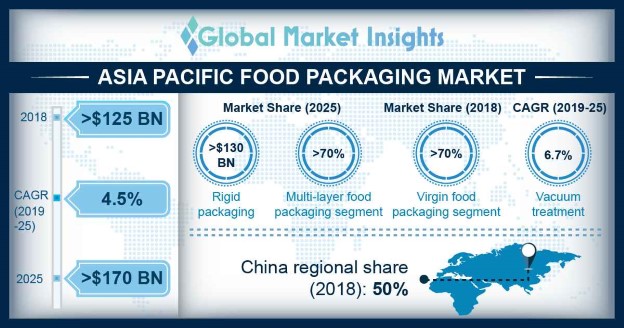Get a free sample of Asia Pacific Food Packaging Market
Thank you!
Your inquiry has been received. Our team will reach out to you with the required details via email. To ensure that you don't miss their response, kindly remember to check your spam folder as well!
Form submitted successfully!
Error submitting form. Please try again.
Get a free sample of Asia Pacific Food Packaging Market
Thank you!
Your inquiry has been received. Our team will reach out to you with the required details via email. To ensure that you don't miss their response, kindly remember to check your spam folder as well!
Form submitted successfully!
Error submitting form. Please try again.
Asia Pacific Food Packaging Market Size
Asia Pacific Food Packaging Market size was valued at over USD 125 billion in 2018 and is estimated to exhibit over 4.5% CAGR from 2019 to 2025.

The e-commerce platform in the food industry has gained a significant acceptance in the region. This is because, it not only provides a wide range of food products but also ensures timely delivery of these products with appropriate packaging. Therefore, with the rise of e-commerce, the demand for food packaging is likely to increase. This is because proper and advanced packaging not only maintains the quality of the product but also increases its shelf life. Moreover, it also allows manufacturers to maintain proper inventory with an adequate lead time for the next supply of perishable food products. In addition to this, the packaging also plays a vital role from the distributors’ side of the value chain by maintaining the quality of the manufactured food for a longer duration and better transportation. The packaging food industries comprise companies that pack food in different types of materials including paperboard, glass, plastic, wood, and aluminum canning for retail sales.
Food packing includes packaging of flavored snacks, confections such as candy & chocolate, bread & cakes, cereals & oatmeal, meat & seafood, fruits, vegetables, cheeses, and condiments; for instance, ketchup and this category also comprises ready-to-eat packaged meals. Thus, food packing has increased the demand for food through internet retail spending. The current social & economic trends for processed & packed food consumption have witnessed a sharp growth over the past few years. The consumption of packaged breakfast cereals and different meals has surged over the years, providing a humongous growth in the packaged food industry.
Sizable economies in the region including China, India, Japan, Australia, and South Korea have set several regulations in order to monitor the quality and safety of packed food products. Regulations in these countries mainly emphasize on food quality, safety, and packaging norms. Food safety law, regulation for food contact materials, and food sanitation law are among the most commonly followed food regulations across the region, ensuring food safety in order to protect the physical health and life safety of the public. Similarly, stringent regulations toward food packaging and food contact materials may restrict growth in the food packing market over the near term. For instance, Food Safety and Standards Authority of India (FSSAI) in January 2019, announced new regulations with respect to food packing, which stresses the importance of packaging materials used for packing food.
What is the anticipated growth for the asia pacific food packaging industry over the forecast duration?
The overall asia pacific food packaging market is anticipated to record a crcr of 4.5% through 2025
How much did the global asia pacific food packaging market size account for in 2018?
The valuation of asia pacific food packaging market in the year 2018 was USD 125 billion.
Which is the fastest growing food packaging technology?
Retort packaging is the fastest growing packaging technology owing to low manufacturing cost that uses laminates of flexible plastic and metal foils. The retort packaging accounts for over USD 8 billion of the overall revenue in 2018.
How much APAC food packing industry share does China hold?
Report estimates, China is the largest market for food packing that accounts for nearly 50% of share in the regional market.
Why does plastic material dominate the APAC food packaging industry?
According to this report, plastic dominates the revenue segment with the market share of more than 50% in 2018 due to its durability, flexibility and ability to resist external influences that makes it favorable for food packing.
What will be the market share of virgin materials in food packaging?
Virgin food packaging is expected to account for more than 70% volume share in the coming years, says a report by GMI.